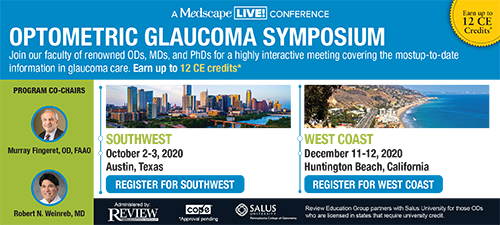
A
weekly e-journal by Art Epstein, OD, FAAO
Off the Cuff: What’s Worse?
We are in the middle of a global pandemic. The US has been hit harder than any other country has been. While it continues to evolve, it’s time we had a serious conversation about the COVID outbreak. It’s been more than six months since the first cases appeared in China, and its increasingly apparent that we actually know very little about COVID-19. We really don’t know how its transmitted or even if someone who had it and recovered is now immune. Most of us are spending a lot of time disinfecting counters in our offices and wiping down grocery bags at home. Your hands are likely raw from constant obsessive washing. Your scrubs probably reek of hand sanitizer. Is all of that keeping us and our patients safe? Infection requires a not-insignificant viral inoculum. How much virus could there be on a grocery bag or a countertop? Are people sneezing on grocery bags or coughing on your office counters? Let’s say you actually got COVID on your hand and inadvertently touched your face, how would the virus get from your cheek up into your nose? Viruses, after all, are just miniscule inanimate blobs of DNA and don’t have legs to walk there. COVID-19, as I said months ago, is an aerosolized airborne virus likely spread by rebreathing an infected person’s breath. Symptomatic or not symptomatic makes no difference. Breath is breath. Mask wearing experience in other countries and recent experience in the US essentially confirms this. Yet, mask wearing has somehow become a political issue when, in reality, it is a common-sense health issue. How did this happen? Listen to the news. All you hear is how bad things are. And yes, I know people who have died from COVID, and trust that I don’t want anyone to get infected or, worse yet, to be sickened by it. Yet, when you look at it from even the slightest objective distance, COVID has so far killed approximately 122,000 out of 330,000,000 Americans or .037% of the population—many of them in nursing homes and also suffering from other illnesses. I live in Arizona, and numbers are rising here as well as increasing in other states. We hear about that every day. But does this reflect the natural course of a very contagious viral infection, or poor leadership and lack of control over things that could have been better controlled? I suspect the power of nature will ultimately trump any possible human intervention. Interestingly, the death rate from COVID in the US has dropped to levels last seen in late March, but you won’t hear that on the news. Hmmm…. A bit more than 50 years ago I was at Woodstock. Back then, the world was in the throes of a killer global pandemic not unlike what we’re seeing today from an infectious disease perspective, but totally different in almost every other way. H3N2, or the so-called Hong Kong flu, killed well over 1 million and possibly as many as 4 million globally, and over 100,000 in the US between 1968 and 1970. You might think that the world would have stopped, but the reality is that virtually everyone completely ignored it. There were no newspaper headlines about the outbreak—none. People just accepted it and believed that modern medical science would find a cure, which it eventually did with a vaccine. Granted, it was a different time and much of the population in the 60s had lived through the preantibiotic era when people died from simple infections. But I think there is more to the differences than that.Common sense and simple intelligence strongly suggest that we do everything possible to minimize risk for ourselves, our families and our patients. We must also be socially responsible and protect those around us. No one sane would argue against that. However, when future generations look back on COVID-19, I wonder if they will see the death and human suffering, the unnecessary economic devastation, or an out of control news media weaponizing and politicizing the outbreak, causing irreparable damage to the very social fabric of our country as most defining of this still evolving tragedy. Time will tell.
|
|||||
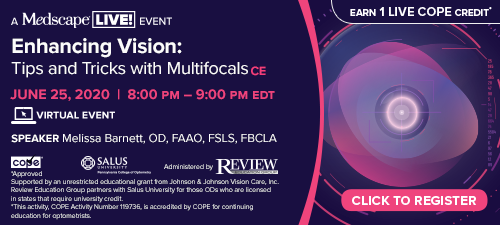 |
||
| Clinical Trial to Evaluate the Therapeutic Benefits of Limbal-Supported Contact Lens Wear for Ocular Sequelae Due to Stevens-Johnson Syndrome/Toxic Epidermal Necrolysis | ||||
To analyze the therapeutic benefits of limbal-supported contact lens (CL) wear in patients with ocular sequelae due to Stevens-Johnson syndrome (SJS)/toxic epidermal necrolysis (TEN), this interventional study enrolled 10 chronic SJS/TEN eyes with a spectacle best-corrected visual acuity (BCVA) of between 0.01 and 0.7 that were fitted with a limbal-supported CL. At baseline and after three-months CL use, CL-wear BCVA and the 25-item National Eye Institute Visual Function Questionnaire (NEI VFQ-25) scores were measured, and then compared. Incidence rates and severities of adverse events were also analyzed. After three-months CL use, BCVA with the fitted CL significantly improved compared to that with spectacle correction at baseline (LogMAR: 0.76 to 0.15). All NEI VFQ-25 scores improved, although only in ocular pain, and mental health showed statistically significant improvement. No serious adverse events were observed during the follow-up. |
||||
SOURCE: Itoi M, Ueta M, Ogino K, et al. Clinical trial to evaluate the therapeutic benefits of limbal-supported contact lens wear for ocular sequelae due to Stevens-Johnson syndrome/toxic epidermal necrolysis. Cont Lens Anterior Eye. 2020;S1367-0484(20)30108-9. |
||||
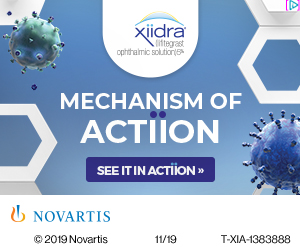 |
||
| Seventy-one Cases of Uveitis-Glaucoma-Hyphaema Syndrome | ||||
To assess Uveitis-Glaucoma-Hyphaema syndrome (UGH syndrome) with a focus on resolution, glaucoma development and risk factors, this retrospective case-control study with a cross-sectional component was performed to compare three groups with 71 patients each: UGH syndrome, dislocated intraocular lens (IOL) without UGH syndrome and ordinary pseudophakia. Main outcome measures were resolution of the UGH syndrome, best-corrected visual acuity (BCVA) and the need of glaucoma therapy. Researchers also assessed the IOL-iris contact signs and the use of blood thinners. Uveitis-Glaucoma-Hyphaema (UGH) syndrome resolved in 77 % of patients who underwent various kind of IOL surgery. Intraocular pressure (IOP) decreased and BCVA improved in the operated cases, but not in the cases treated conservatively. Intraocular pressure (IOP) ≥22 mmHg at the first hemorrhage predicted the need for glaucoma therapy after UGH syndrome resolution. Fifty-one percent of patients without pre-existing glaucoma needed glaucoma therapy after UGH syndrome resolution. Pseudophacodonesis was seen more frequently in the UGH group than in the ordinary pseudophakia group. Iris defects were not more frequent in the UGH group than in the dislocated group, but the types of defects differed. Blood thinners were not more frequent in UGH. In UGH syndrome, the results were better with surgical intervention than with conservative treatment, but surgery did not guarantee resolution. Pseudophacodonesis was a risk factor for UGH syndrome, but blood thinners were not, and iris defects were not specific to UGH syndrome. A high IOP at the first hemorrhage increased the risk for needing subsequent IOP-lowering therapy.
|
||||
SOURCE: Armonaite L, Behndig A. Seventy-one cases of uveitis-glaucoma-hyphaema syndrome. Acta Ophthalmol. 2020 Jun 8. [Epub ahead of print]. |
||||
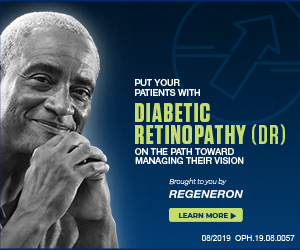 |
||
| Optomap Ultra-widefield Imaging for Detecting Peripheral Retinal Lesions in 1,725 High Myopic Eyes Before Implantable Collamer Lens Surgery | ||||
Investigators analyzed the specificity and sensitivity of non-mydriatic Optomap ultra-widefield imaging for detecting and identifying peripheral retinal lesions in high myopia patients before implantable collamer lens (ICL) surgery. A total of 1,725 highly myopic eyes of 897 ICL surgery candidates were included in this study. Patients with high myopia were scheduled for routine ophthalmic examination before ICL implantation. Non-mydriatic Optomap ultra-widefield imaging was conducted for detecting potential peripheral retinal lesions before ICL surgery. A total of 344 (19.94%) of 1,725 eyes had peripheral retinal lesions in total. A total of 75 (4.35%) eyes had holes/tears. A total of 313 (18.14%) eyes had peripheral retinal degenerations. The sensitivity of Optomap for detecting peripheral retinal holes/tears and degenerations was 57.33% (95% CI: 45.38-68.69%) and 65.18% (95% CI: 59.61-70.45%). Specificity for peripheral retinal holes/tears and degenerations were 99.58% (95% CI: 99.13-99.83%) and 99.08% (95% CI: 98.43-99.51%), respectively. 22.7% (32/141) of omitted peripheral retinal lesions under Optomap needed intervention. Longer axial length, more severe refractive error and older age were proved to be risk factors for peripheral retinal degenerations in high myopes. Investigators concluded that Optomap ultra-widefield imaging was a reliable adjunctive tool with high specificity and moderate sensitivity for identifying and recording peripheral retinal lesions in high myopes in preoperative examination. They wrote that non-mydriatic Optomap could not entirely replace Goldmann three-mirror contact lens in detecting peripheral retinal lesions in high myopia ICL candidates.
|
||||
SOURCE: Yang D, Li M, Wei R, et al. Optomap ultrawide field imaging for detecting peripheral retinal lesions in 1725 high myopic eyes before implantable collamer lens surgery. Clin Exp Ophthalmol. 2020 Jun 8. Online ahead of print. |
||||
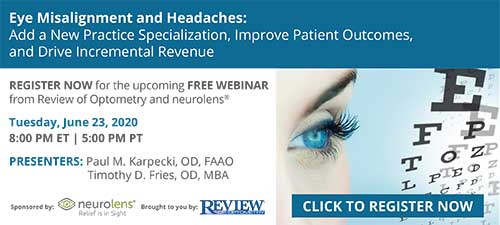 |
||
| News & Notes | ||||||||
| ImprimisRx Klarity-C 0.1% Cyclosporine Preservative-free Formulation Can Now be Prescribed by Florida ODs ImprimisRx announced its Klarity-C preservative-free formulation (0.1% cyclosporine emulsion) can now be prescribed by Florida’s optometrists as a result of the Florida Board of Optometry’s recent additions to its Formulary of Topical Ocular Pharmaceutical Agents. Klarity-C, which is produced according to the highest federal manufacturing standards at the ImprimisRx FDA-registered outsourcing facility, has been one of ImprimisRx’s fastest growing topical formulations. Read more. |
||||||||
|
||||||||
| Hilco Vision Acquires Suppleyes Hilco Vision acquired Mississippi-based ophthalmic supplies company, Suppleyes, effective June 1. Hilco Vision is an industry-leading global eyewear/eye care company delivering comprehensive solutions to customers, built on a platform of innovation and operational excellence. It has direct subsidiaries, including Eye Care and Cure, in the United States, Canada, the UK, Germany, Australia, China and the Netherlands. The company’s product portfolio is concentrated on five primary product categories: professional tools, vision protection, consumer accessories, lens care and ophthalmic supplies. Read more.
|
||||||||
| Tarsus Announces Positive Results from Mars Study Tarsus Pharmaceuticals announced positive results from its Phase IIa Mars Study. The Mars study demonstrated that the use of TP-03 for four weeks was well-tolerated and showed promising efficacy in the treatment of demodex blepharitis with treatment effects persisting for at least 90 days. Mars was a single-arm, open-label study that evaluated the safety and efficacy of TP-03 in 15 participants with demodex blepharitis. Read more.
|
||||||||
| Study with Patient-operated Home OCT Begins Notal Vision announced the enrollment of patients in the first longitudinal home-based study with its investigational home optical coherence tomography remote monitoring device. The study will explore the daily dynamics of retinal fluid in patients receiving anti-VEGF treatment for wet age-related macular degeneration. The Home OCT System pipeline technology is designed to provide home-based, patient-initiated retinal OCT scans to support the management of patients with wet AMD. Read more. |
||||||||
|
Optometric Physician™ (OP) newsletter is owned and published by Dr. Arthur Epstein. It is distributed by the Review Group, a Division of Jobson Medical Information LLC (JMI), 19 Campus Boulevard, Newtown Square, PA 19073. HOW TO ADVERTISE |



